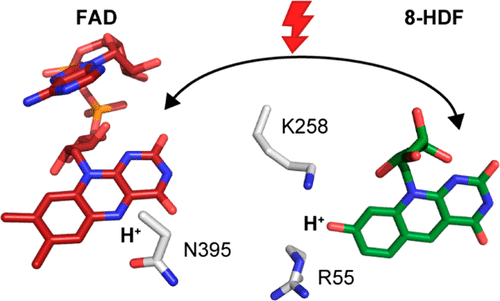当前位置:
X-MOL 学术
›
Biochemistry
›
论文详情
Our official English website, www.x-mol.net, welcomes your feedback! (Note: you will need to create a separate account there.)
Interconnection of the Antenna Pigment 8-HDF and Flavin Facilitates Red-Light Reception in a Bifunctional Animal-like Cryptochrome.
Biochemistry ( IF 2.9 ) Pub Date : 2019-12-26 , DOI: 10.1021/acs.biochem.9b00875 Sabine Oldemeyer 1, 2 , Andrew Z Haddad 3 , Graham R Fleming 1, 2, 4
Biochemistry ( IF 2.9 ) Pub Date : 2019-12-26 , DOI: 10.1021/acs.biochem.9b00875 Sabine Oldemeyer 1, 2 , Andrew Z Haddad 3 , Graham R Fleming 1, 2, 4
Affiliation

|
Cryptochromes are ubiquitous flavin-binding light sensors closely related to DNA-repairing photolyases. The animal-like cryptochrome CraCRY from the green alga Chlamydomonas reinhardtii challenges the paradigm of cryptochromes as pure blue-light receptors by acting as a (6-4) photolyase, using 8-hydroxy-5-deazaflavin (8-HDF) as a light-harvesting antenna with a 17.4 Å distance to flavin and showing spectral sensitivity up to 680 nm. The expanded action spectrum is attributed to the presence of the flavin neutral radical (FADH•) in the dark, despite a rapid FADH• decay observed in vitro in samples exclusively carrying flavin. Herein, the red-light response of CraCRY carrying flavin and 8-HDF was studied, revealing a 3-fold prolongation of the FADH• lifetime in the presence of 8-HDF. Millisecond time-resolved ultraviolet-visible spectroscopy showed the red-light-induced formation and decay of an absorbance band at 458 nm concomitant with flavin reduction. Time-resolved Fourier transform infrared (FTIR) spectroscopy and density functional theory attributed these changes to the deprotonation of 8-HDF, challenging the paradigm of 8-HDF being permanently deprotonated in photolyases. FTIR spectra showed changes in the hydrogen bonding network of asparagine 395, a residue suggested to indirectly control flavin protonation, indicating the involvement of N395 in the stabilization of FADH•. Fluorescence spectroscopy revealed a decrease in the energy transfer efficiency of 8-HDF upon flavin reduction, possibly linked to 8-HDF deprotonation. The discovery of the interdependence of flavin and 8-HDF beyond energy transfer processes highlights the essential role of the antenna, introducing a new concept enabling CraCRY and possibly other bifunctional cryptochromes to fulfill their dual function.
中文翻译:

天线色素8-HDF和黄素的互连促进了双功能动物状隐色中的红光接收。
隐色是无处不在的黄素结合光传感器,与DNA修复光解酶密切相关。绿藻衣藻(Chlamydomonas reinhardtii)的动物状隐色染料CraCRY通过使用(8-4-羟基-5-脱氮基黄素)(8-HDF)作为光(6-4)光裂解酶,挑战了纯色素作为纯蓝光受体的范式。到黄素的17.4Å距离的天线,并显示高达680 nm的光谱灵敏度。尽管在体外仅携带黄素的样品中观察到FADH•快速衰减,但扩展的作用谱归因于在黑暗中存在黄素中性自由基(FADH•)。在本文中,研究了带有黄素和8-HDF的CraCRY的红光响应,揭示了在存在8-HDF的情况下FADH•寿命延长了3倍。毫秒时间分辨紫外可见光谱显示红光诱导的458 nm吸光度带的形成和衰减,并伴有黄素减少。时间分辨傅立叶变换红外(FTIR)光谱学和密度泛函理论将这些变化归因于8-HDF的去质子化,挑战了8-HDF在光解酶中永久去质子化的范式。FTIR光谱显示天冬酰胺395的氢键网络发生了变化,该残基建议间接控制黄素质子化,表明N395参与了FADH•的稳定化。荧光光谱法揭示了黄素还原后8-HDF的能量转移效率降低,可能与8-HDF去质子化有关。
更新日期:2019-12-27
中文翻译:

天线色素8-HDF和黄素的互连促进了双功能动物状隐色中的红光接收。
隐色是无处不在的黄素结合光传感器,与DNA修复光解酶密切相关。绿藻衣藻(Chlamydomonas reinhardtii)的动物状隐色染料CraCRY通过使用(8-4-羟基-5-脱氮基黄素)(8-HDF)作为光(6-4)光裂解酶,挑战了纯色素作为纯蓝光受体的范式。到黄素的17.4Å距离的天线,并显示高达680 nm的光谱灵敏度。尽管在体外仅携带黄素的样品中观察到FADH•快速衰减,但扩展的作用谱归因于在黑暗中存在黄素中性自由基(FADH•)。在本文中,研究了带有黄素和8-HDF的CraCRY的红光响应,揭示了在存在8-HDF的情况下FADH•寿命延长了3倍。毫秒时间分辨紫外可见光谱显示红光诱导的458 nm吸光度带的形成和衰减,并伴有黄素减少。时间分辨傅立叶变换红外(FTIR)光谱学和密度泛函理论将这些变化归因于8-HDF的去质子化,挑战了8-HDF在光解酶中永久去质子化的范式。FTIR光谱显示天冬酰胺395的氢键网络发生了变化,该残基建议间接控制黄素质子化,表明N395参与了FADH•的稳定化。荧光光谱法揭示了黄素还原后8-HDF的能量转移效率降低,可能与8-HDF去质子化有关。



























 京公网安备 11010802027423号
京公网安备 11010802027423号